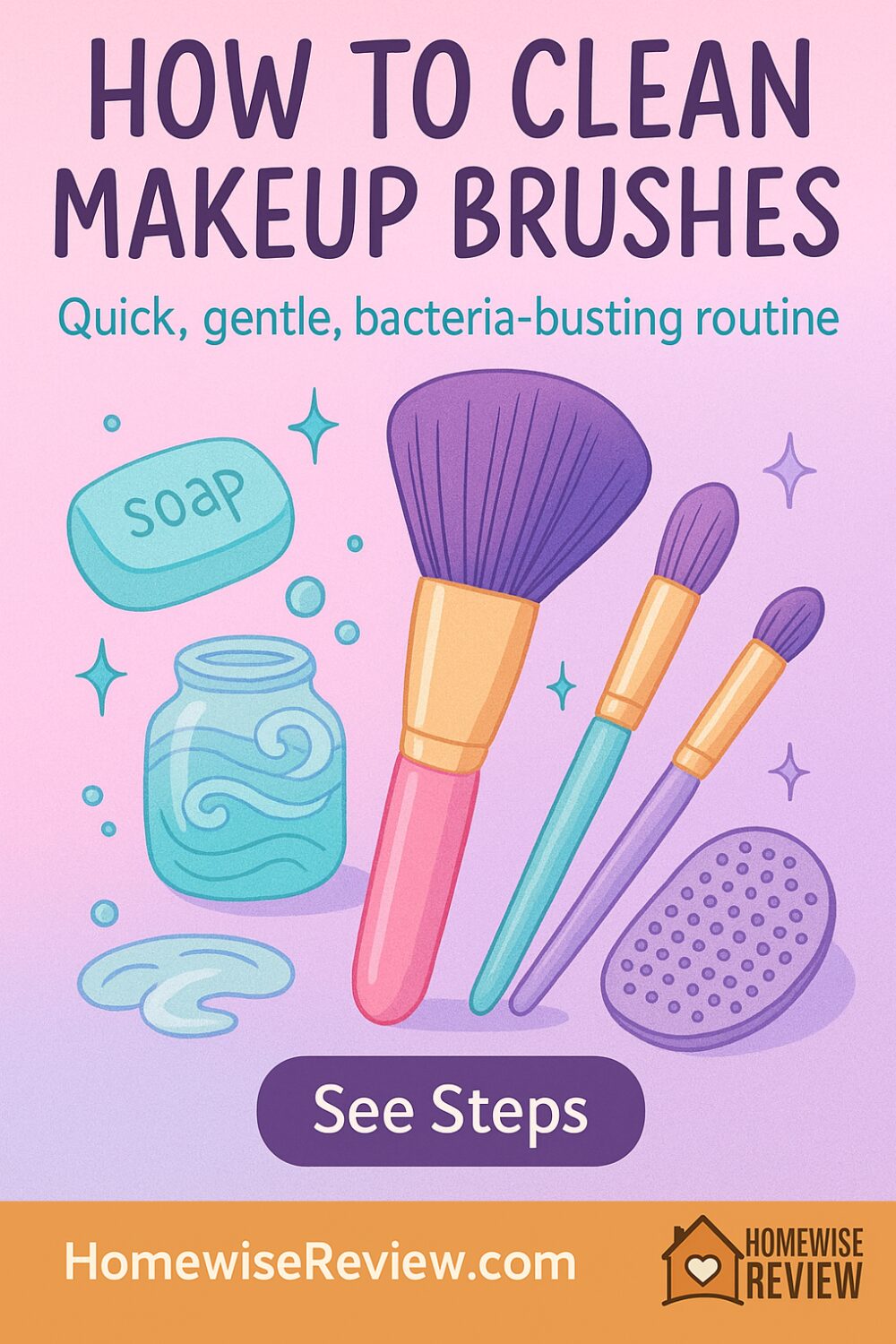
Being a mom often means your mornings are a blur – breakfast to make, kids to dress, maybe a last-minute Zoom meeting. In the rush, it’s easy to overlook the little things, like cleaning your makeup brushes. But taking time to wash those brushes is more than just busy-work. It can save you precious minutes in your routine (clean brushes apply makeup faster and more evenly) and even protect your skin. Dirty brushes accumulate old makeup, oils, and bacteria that you end up brushing onto your face. The result? Patchy application, more breakouts, and even the risk of nasty skin infections if left unchecked. In fact, one study found up to 90% of used makeup tools carry bacteria or fungus – including acne-causing germs and even staph. Regular brush cleaning helps avoid those problems and keeps your complexion happier.
Why regular cleaning matters: Beyond skin health, clean brushes just work better. Ever noticed your foundation looking streaky or your eyeshadow muddy? Often, that’s your brush crying for a wash. Product buildup on bristles can make even high-end makeup perform poorly. By washing away the gunk, you restore your brushes’ soft, fluffy texture and ensure truer color payoff and smoother blending sydoniskin.com. Plus, good brushes aren’t cheap – and cleaning them routinely extends their lifespan. For time-poor, beauty-conscious moms, this is a win-win: fewer surprise breakouts, better-looking makeup in fewer swipes, and no need to replace brushes as often. Let’s dive into a simple step-by-step guide that will fit into your busy schedule and keep your brushes (and skin) in top shape.
Step-by-Step: How to Clean Makeup Brushes
Cleaning your makeup brushes at home is straightforward. You don’t need fancy equipment – gentle household products like a mild shampoo or soap work perfectly, and there are professional brush cleansers if you prefer. Here’s how to do a thorough clean in five easy steps:
- Wet the bristles: Start by rinsing only the brush bristles under lukewarm running water. Keep the ferrule (the metal part) and handle dry – don’t soak the whole brush. Too much water can loosen the glue holding the bristles, causing shedding over time. Use warm (not hot) water to avoid damaging the bristles.
- Add cleanser and swirl: Place a small drop of a gentle cleanser in your palm (or into a shallow bowl of water). You can use a baby shampoo or mild clarifying shampoo – if it’s safe for your hair or skin, it’s safe for your brushes. For especially dirty synthetic brushes (like those caked with long-wear foundation), a tiny dab of dish soap can help cut through oilsi, but avoid harsh detergents on natural-hair brushes. Gently swirl the wet brush bristles in the soap, using circular motions. Work up a light lather and massage the bristle tips with your fingers to lift out makeup and dirt. (Tip: A textured brush cleaning mat or glove can make this step easier and more fun vivatowels.com.)
- Rinse and repeat: Rinse the brush under lukewarm water again, bristles pointing downward. You’ll see makeup pigment and soap washing out. Squeeze the bristles lightly to check if the water runs clear. If you still see murky water or residual color, repeat the cleanse (add a bit more soap and swirl again) until the water runs clear from the brush. This extra pass is worth it – any leftover makeup can cake up once dry. Take your time especially with dense foundation or concealer brushes, which tend to hold more product.
- Gently remove excess water: Once the bristles are clean, gently squeeze out excess water using a clean towel or paper towel. Don’t yank or pull on the bristles – just press and squeeze softly from base to tip. The goal is to remove as much moisture as you can without disturbing the shape of the brush. Never twist or aggressively wring out brushes, as this can damage the bristles. A soft pat or squeeze will do. At this stage, your brushes should be clean and just damp.
- Reshape and dry properly: Reshape the brush head with your fingers so the bristles are aligned in their original form. This prevents splaying or frizzing as they dry. Lay the brushes flat on a clean towel, preferably with the bristle end hanging off the edge of a counter or table. This way, air circulates around the bristles and no water seeps back into the ferrule. Do not dry brushes upright in a cup while wet – water can run down into the handle and loosen the glue over time. Let brushes air-dry completely for several hours or overnight. (Many moms wash brushes at night so they’re fresh and dry by morning.) If you’re in a hurry and absolutely need a brush sooner, you can use a hair dryer on a cool setting at least a few inches away for a quick blast – but avoid high heat, which can singe bristles or crack the handle. Patience is usually best: by morning, your brushes will be fluffy, clean, and ready to go!
Most importantly, aim to wash your brushes about once a week. Dermatologists recommend a full cleaning every 7–10 days to keep bacteria at bay. If that sounds tough to manage, start with washing your most-used brushes (e.g. foundation, powder) weekly and eye brushes every other week. In the next section, we’ll share some practical tips to make regular cleaning easier and keep your brushes in great condition.
Tips for Easier Brush Cleaning and Care
- Make it a weekly ritual: The key to cleaning brushes regularly is to build it into your routine. If you’re time-poor on weekdays, pick a low-key moment – say, Sunday night self-care time – to wash your brushes. It literally only takes a few minutes (you can even do it while listening to a podcast or supervising the kids’ homework). By making it a habit, you’ll prevent heavy buildup, so each cleaning is quicker. Remember, a quick weekly wash is easier than scrubbing month-old foundation gunk!
- Use quick cleaners between washes: If washing every single brush sounds daunting, consider a makeup brush cleaning spray or daily brush cleaner for in-between use. These are alcohol-based sprays or solutions you spritz on the bristles and wipe off on a towel. They’re great for spot-cleaning eyeshadow brushes when switching colors, or giving a foundation brush a mid-week refresh. (Keep in mind, though, these are just quick fixes – you’ll still want a deep clean with soap and water weekly or so.) Some pros even use a bit of hand sanitizer on synthetic brushes after each use for a fast disinfecting swipe intothegloss.com. Just be sure to rinse and deep clean later, as hand sanitizer can dry out bristles if left on.
- Try the olive oil trick for stubborn makeup: For brushes caked with long-wear or waterproof makeup, a two-step cleanse can help. First, dip the bristles in a tiny amount of olive oil or conditioning oil and massage – this helps break down waxy or waterproof products. Then proceed with your normal soapy wash. The oil step conditions the bristles and lifts heavy pigments, so your gentle shampoo can wash everything out more easily. (Alternatively, a drop of dish soap works well on synthetic brushes to cut through oily foundation or sunscreen residue – just rinse thoroughly and don’t use dish soap on natural hair bristles too often, as it can be drying.)
- Dry brushes faster (but safely): Need your brushes dry sooner? After washing, wrap each brush head in a paper towel and squeeze again to draw out extra water. You can also gently fluff the bristles with a towel to speed up evaporation. To accelerate drying, place the brushes near a fan or open window for airflow. What about using a hair dryer? It’s best to avoid high heat, which can damage the brush. If you must, use only cool air at a distance. Also, never place wet brushes on a radiator or heater – extreme heat can warp the bristles (and potentially burn them). The safest bet is air-drying, so plan ahead and wash when you won’t need the brushes immediately (like overnight).
- Keep brush shape and quality: While drying, reshape the bristles to their original form (as mentioned in the steps). For very fluffy brushes, you can even slip a brush guard (a mesh sleeve) over the bristles to help them keep shape while drying. Once dry, store your brushes upright in a cup or stand, if possible, to maintain their shape. Avoid cramming damp brushes in a drawer – they might develop a funny smell or even mildew. And speaking of smells, if your brushes ever develop a musty odor (often from not drying fully), wash them again and this time let them dry completely in a breezy spot.
- Store smart to extend life: Where you keep your brushes matters. Avoid damp, humid places like right next to the steamy shower – excess humidity can weaken the glue in the brush handle over time. A dry area of your bedroom or vanity is better. If you toss brushes in a makeup bag, try to keep them in a separate pouch or upright case so the bristles don’t get smashed or dirty from leaked products. Many brush sets come in cylinders or cases – those are perfect for travel or in your purse. By storing brushes clean, dry, and protected, you’ll keep them sanitary and make them last for years.
- Don’t forget your sponges and tools: This guide is all about brushes, but if you also use makeup sponges (blenders) or powder puffs, show them some love too. Sponges absorb even more product and can breed bacteria just as fast (if not faster) than brushes. Get in the habit of washing your sponge with gentle soap and warm water every few uses (or even daily for a Beautyblender), and replace sponges every few months if they start to tear or retain stains. Similarly, wipe down eyelash curlers, tweezers, and other beauty tools with a bit of alcohol periodically. Clean tools all around = better skin and makeup!
By following these tips, you’ll find that keeping your brushes clean becomes almost second nature. Next, let’s cover a few common mistakes to avoid when cleaning your brushes, so you can sidestep any pitfalls and keep those tools in tip-top shape.
Common Mistakes to Avoid
Even with the best intentions, it’s possible to unintentionally damage your brushes or undermine your cleaning efforts. Here are some common brush-cleaning mistakes and how to avoid them:
- Waiting too long between cleanings: The biggest mistake is simply not washing often enough. Using the same dirty brush for weeks or months allows bacteria to build up, which can lead to breakouts and “muddy” makeup colors. Fix it by washing brushes weekly (or at least every 2 weeks for seldom-used ones). Your skin will thank you, and so will your makeup’s finish.
- Soaking the entire brush in water: Dunking your whole brush into a sink full of water might sound thorough, but it’s a fast track to ruining it. Never submerge the brush past the bristles. Water can seep into the ferrule and handle, loosening the glue that holds bristles and even cracking wooden handles. Always wet just the bristles and avoid getting the handle overly wet.
- Using harsh cleaners (or the wrong products): Skip bleach, undiluted vinegar, or strong detergents on your brushes – these can dry out or fray the bristles (especially natural hair) and leave irritating residue. Even dish soap, while effective for heavy grime, shouldn’t be your everyday cleanser for brushes (save it for occasional deep cleans on synthetic bristles). Stick to gentle soaps, baby shampoo, or dedicated brush cleaners, and rinse thoroughly so no cleanser is left behind. If you see leftover suds or smell soap on the brush after drying, it’s a sign to rinse again.
- Rinsing with hot water: We love hot showers, but your brushes don’t. Hot water can melt glues and warp bristles. Always use lukewarm or cool water when washing and rinsing brushes. It’s gentler on both the bristles and any adhesive parts of the brush.
- Scrubbing or pulling at bristles: It might be tempting to really “scrub” a dirty brush or yank out clumps of foundation from it. But aggressive handling is a no-no. Don’t yank on the brush hairs – you’ll end up pulling them out. Instead, use gentle swirling and massaging motions to clean (as described in the steps). For tangles in brush hair, use your fingers to softly coax them apart. Treat your brushes with the same care you’d treat your own hair.
- Drying brushes upright (or not drying fully): This bears repeating because it’s a common misstep – never dry your brushes standing bristle-up in a cup while wet aad.org. Water will trickle down and weaken the brush from the inside. Also, avoid tossing damp brushes into a closed drawer or makeup bag. Trapped moisture can lead to mildew or that funky smell. Always dry brushes flat, in fresh air, until completely dry. A little patience here preserves your brushes (and keeps gross bacteria or mold from setting up home in them).
- Using a hair dryer on high heat: We mentioned this in tips, but it’s worth highlighting as a mistake to avoid. Blasting your damp brushes with a hot hair dryer can singe synthetic bristles or cause natural hairs to become brittle. High heat might also warp the shape of the brush. If you need to speed up drying, only use a cool, low setting briefly goop.com – and even then, sparingly. In general, it’s safest to let brushes air-dry.
- Sharing brushes between people: Lending your best friend or daughter a brush might seem harmless, but it’s a quick way to swap germs. Avoid sharing your makeup brushes with others. If you do share (say, in a pinch), be sure to clean the brush thoroughly before and after use. It’s better to provide a clean disposable applicator than risk spreading bacteria.
By steering clear of these mistakes, you’ll ensure your brush cleaning sessions are effective and your brushes stay in great shape. Now, to address a few lingering questions you might have, let’s move on to a quick FAQ.
See also
If you’re revamping your beauty routine, you might also want to check out our related guides on brushes and makeup. For instance, upgrading your tool kit can make cleaning easier (with more brushes to rotate) and makeup application faster. Our guide to Best Makeup Brushes: Faster Blending, Better Results covers top-quality brush picks that make a 5-minute face truly achievable (the right bristles can make all the difference in how quickly and flawlessly you blend). And if you’re watching your budget, don’t miss Best Affordable Makeup Brushes for Busy Moms – it highlights wallet-friendly brush sets that don’t skimp on quality or durability. These articles will help you find reliable tools that are easy to use and maintain, so you can feel confident when it’s time to clean them and put them to work.
For more beauty wisdom tailored to busy women, take a peek at Makeup Mistakes You Probably Make. This piece walks through common makeup pitfalls and quick fixes – and yes, not cleaning your brushes regularly is flagged as a big mistake (one that’s easy to fix with the steps you learned today!). You’ll also find tips on improving your makeup’s longevity and look. And since clean brushes are just one part of the equation for healthy skin, you might be interested in our skincare-related guides – for example, ensuring you remove makeup gently every night. See our roundup of Best Makeup Remover Wipes: Fast, Gentle, No Tugging for mom-approved options to get your face clean in a hurry. By exploring these “see also” articles, you’ll round out your beauty know-how – from picking the right tools, to using them effectively, to keeping everything clean and skin-friendly. Happy brushing and beautifying!
We may earn a small referral fee at no extra cost to you.
FAQ
How often should I clean my makeup brushes?
Ideally once a week. If you wear makeup daily, aim for a weekly deep clean of your brushes. Dermatologists and makeup artists often recommend washing brushes every 7–10 days to prevent bacteria buildup and protect your skin. (Pro tip: wash your foundation and concealer brushes a bit more frequently if you can, since they accumulate oils, and eye brushes at least every couple of weeks if not weekly.) Regular cleaning keeps your tools hygienic and performing their best.
What can I use to clean my makeup brushes if I don’t have a special cleaner?
You likely already have something suitable at home. Gentle baby shampoo is a popular choice – it’s mild and effective for both natural and synthetic bristlesvivatowels.com. A facial cleanser (the kind you’d use on your face) can also work in a pinchcurology.com. For very dirty brushes or ones clogged with oily products, a drop of dish soap mixed with water can help (dish soap is great at cutting grease)intothegloss.com, but use it sparingly so you don’t dry out the bristles. And of course, if you have a makeup brush cleaner solution or solid cleanser, you can use that as directed – those are formulated specifically for brushesvivatowels.com. The key is to avoid anything too harsh or heavily scented. When in doubt, mild soap and lukewarm water will do the job.
Is it okay to use a hair dryer to dry my makeup brushes?
t’s not ideal. The safest way to dry brushes is letting them air-dry naturally. High heat from a hair dryer can damage the bristles or loosen the glue holding them. If you’re in a rush and must speed things up, you can use a hair dryer on a cool, low setting and hold it about 5 inches away, giving a quick blast just to take out dampnessgoop.com. Even then, be gentle and don’t overdo it. Never use hot air or a high-heat setting – that can singe bristles or warp the brush shape. In short, use a towel and patience when possible, and save the hair dryer for your actual hair.




